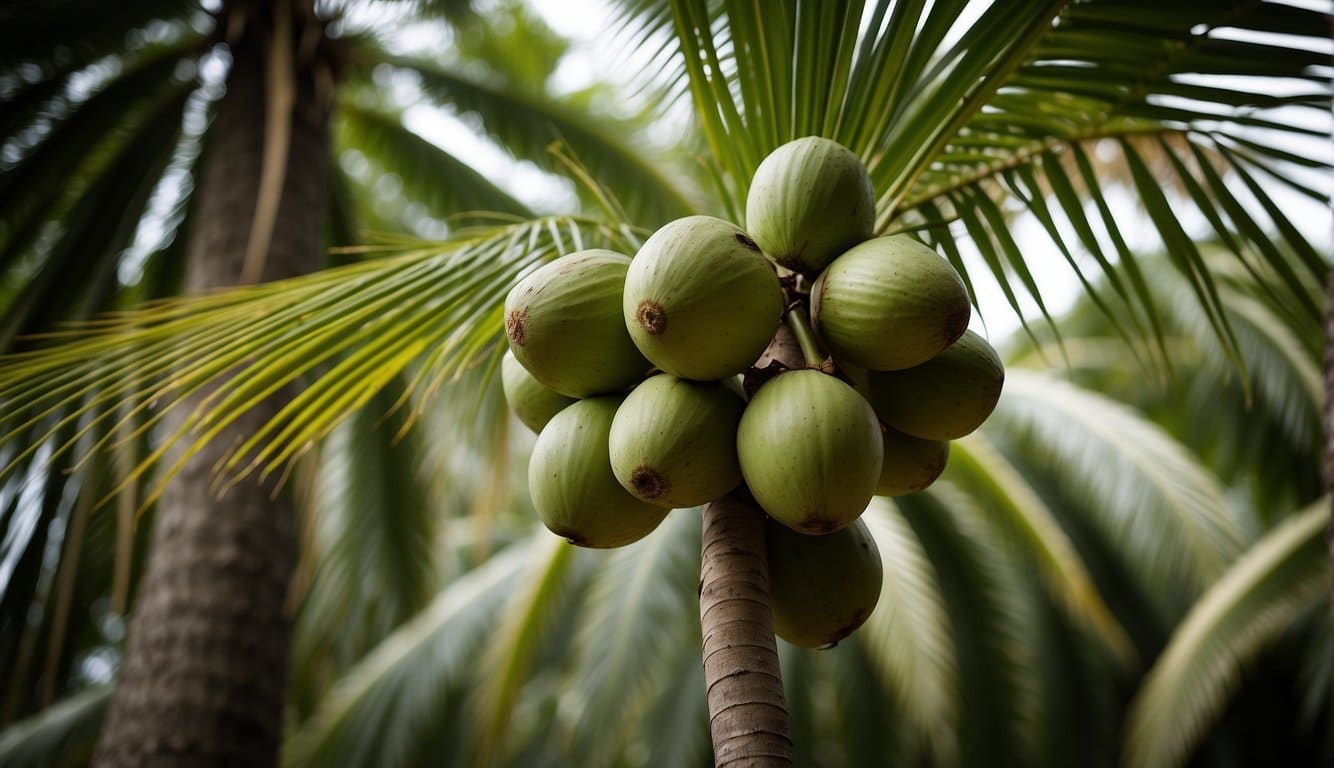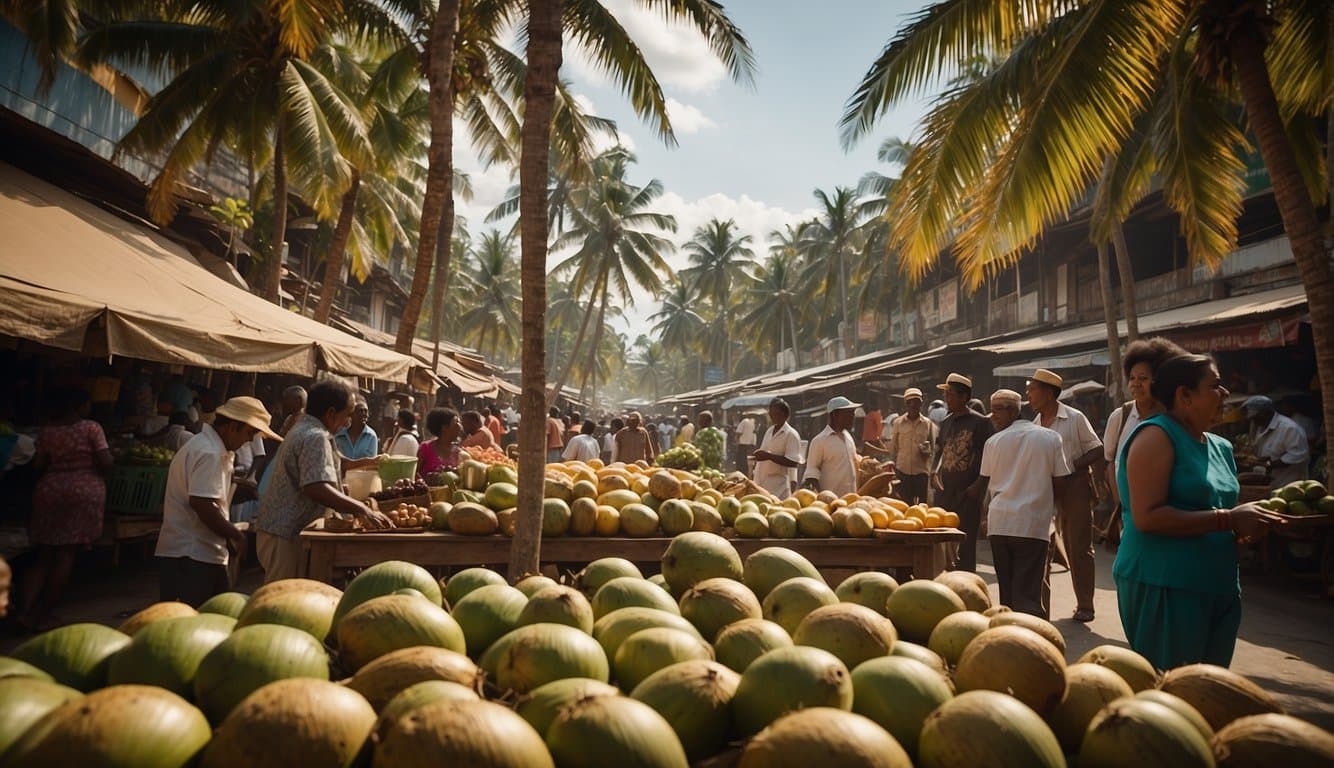Coconut trees and palm trees are often subjects of confusion, owing to the striking similarities and differences that define each species.
Both belonging to the Arecaceae family, these tropical trees share certain characteristics yet maintain unique traits that distinguish one from the other.
The coconut tree, or Cocos nucifera, is noted for its singular focus on producing the fruit for which it is named, while numerous other members of the palm family showcase a variety of forms and functions that extend beyond fruit production.
As important as it is to admire their graceful forms, understanding the botanical characteristics of coconut and palm trees is key to recognizing their distinct identities.
Coconut trees display a smooth, slender profile with a marked tapering trunk capped with large, feather-like leaves and bearing the nutritious coconuts.
On the other hand, the broader classification of palm trees encompasses species with various leaf shapes, trunk sizes, and growth habits.
This diversity is not merely for show; it speaks to the cultural and economic significance of these trees, with their applications ranging from culinary to construction in different parts of the world.
Key Takeaways
- Both coconut and palm trees are from the Arecaceae family yet have distinct physical traits.
- The coconut tree produces coconuts and has a smooth, tapered trunk, while the term ‘palm tree’ includes a wide variety of species with different uses.
- Palm trees, including coconut trees, have adapted to diverse environmental conditions and have significant economic and cultural value.
Botanical Characteristics
Understanding botanical characteristics is essential for distinguishing between coconut trees and other types of palm trees. These characteristics include classification, physical features, and root systems.
Botanical Classification
Coconut trees, known botanically as Cocos nucifera, fall under the Arecaceae family and are indeed a type of palm tree.
They differ from other palms in their genus and species, and they are specifically cultivated for their ability to produce coconuts.
Physical Features
In terms of physical appearance, coconut trees display certain distinct traits:
- Height: They can grow up to 100 feet tall.
- Leaves: Their leaves are pinnate, or feather-shaped, and can reach 12 to 18 feet in length.
- Trunk: Coconut trees possess a smooth trunk with a characteristic bulge at the base and leaf scars.
By contrast, other palm trees vary significantly in their physical structure and may not produce coconuts.
They can have fan-shaped (palmate) or feather-shaped (pinnate) leaves, and their trunks can be thick and robust or slender, with varying types of bark.
Root Systems
Coconut trees have a fibrous root system that spreads out from the base in all directions.
This system aids in the tree’s stability and nutrient absorption. Similarly, other palm trees also possess a fibrous root system though the density and spread can vary based on the species and environment.
Cultural and Economic Significance
Coconut and palm trees have ingrained themselves into the fabric of many societies throughout history, offering both cultural symbols and economic benefits.
Historical Uses
Historically, societies have held the coconut tree in high regard, often attributing it with life-giving properties due to its versatility.
Its parts have been utilized for hydration (coconut water), nutrition (coconut meat and oil), shelter (leaves and wood), and even medicine (traditionally infused concoctions).
Palm trees, on the other hand, have symbolized peace and victory in various cultures and have been used to construct houses, boats, and tools.
Economic Impact
The economic impact of coconut and palm trees is significant, scaling from local to global markets.
Coconut trees are a crucial source of income for tropical countries thanks to products like:
- Copra: Dried coconut meat for oil extraction
- Coir: Fiber from the husk used in brushes, mats, and ropes
- Charcoal: From coconut shells
- Crafts: Ornamental items made from various parts of the tree
Palm trees, especially oil palms, have a vast economic footprint as they produce palm oil, a highly sought-after commodity in the global food industry.
- Palm Oil: Used in food products, personal care, and biofuel
- Dates: From date palms, a staple in Middle Eastern diets
- Landscaping: Ornamental palms add aesthetic value to properties
Environmental Adaptations
Coconut and palm trees display distinct environmental adaptations that allow them to thrive in their preferred habitats. These differences are primarily seen in their climate preferences and soil requirements.
Climate Preferences
- Coconut Trees: They demand a consistently warm climate with temperatures ideally above 50°F (10°C) as cold temperatures can lead to their demise. High humidity and annual rainfall between 30 to 50 inches are conducive to their growth.
- Palm Trees: They exhibit a broader tolerance for climatic conditions.While many palm species prefer tropical environments like coconut trees, others adapt to deserts or temperate zones, showcasing their versatility.
Soil Requirements
- Coconut Trees:
- Texture: Favor sandy, well-drained soils.
- pH: Prefer slightly acidic to neutral soil (pH 5.5 to 7).
- Palm Trees:
- Texture: Soil preferences vary widely; some require well-draining sandy soil, while others grow in loam or clay.
- pH: Can range from acidic to alkaline, depending on the species.
Frequently Asked Questions
This section addresses some of the most commonly asked questions about the differences between coconut trees and other palm trees, as well as their characteristics and growth requirements.
What distinguishes a palm tree from a coconut tree?
A coconut tree is actually a type of palm tree, named specifically for its capacity to produce coconuts. The term “palm tree” encompasses a wider variety of species under the Arecaceae family, of which the coconut tree, Cocos nucifera, is only one.
Can a palm tree produce coconuts in all regions, including Florida?
Not all palm trees produce coconuts. Only the coconut palm produces coconuts, and while it can grow in Florida’s tropical and subtropical climate, other palm species found in Florida may not yield coconuts.
What is the typical height difference between coconut trees and other palm species?
Coconut trees typically reach heights of 16 to 98 feet, depending on the variety. Other palm species can vary greatly in size, with some being small enough to grow indoors to large ones reaching over 60 feet.
Are the leaves of coconut trees distinct from those of other palm trees?
The leaves of coconut trees are pinnate, or feather-like, usually ranging from 15 to 17 feet in length. Other palm species may have similar pinnate leaves or different leaf configurations such as fan-shaped (palmate) leaves.
In which climates and regions are coconut trees capable of thriving?
Coconut trees thrive in tropical climates where temperatures are warm, rainfall is abundant, and the humidity is high. They usually do not tolerate cold weather and are commonly found in places like Southeast Asia, Pacific islands, and the Caribbean.
Is the fruit of all palm trees edible, and how does it compare to coconuts?
Not all palm trees bear edible fruit.
Coconuts are the large seeds of the coconut palm and are unique for their hard shell, fibrous husk, and nutritious interior.
Other palms may produce edible fruits, such as dates from the date palm, but they differ significantly in size, taste, texture, and nutritional content from coconuts.




